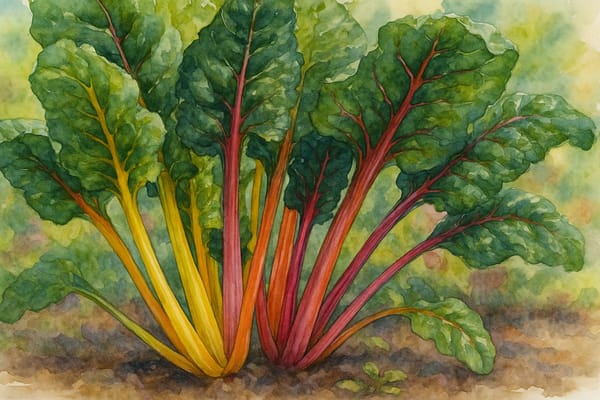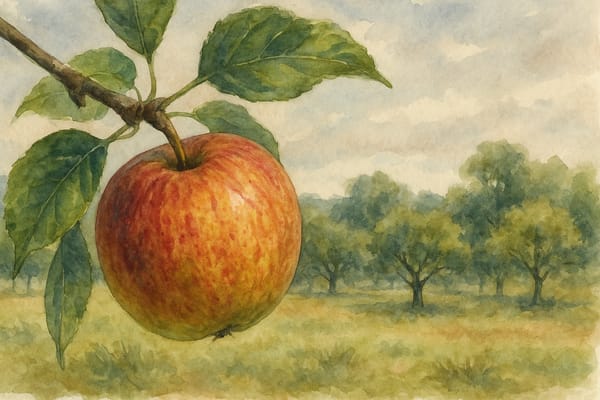In the dappled warmth of a spring garden, few vegetables strike the eye quite like rainbow chard. With its luminous stems—magenta, tangerine, lemon-yellow, snowy white—it’s easy to mistake it for a border perennial rather than a hardworking kitchen crop. But don’t be fooled by the drama: this is a deeply practical, resilient plant, loved by gardeners for its productivity and generous cut-and-come-again nature. And in Cornwall, where the weather runs mild and moist, rainbow chard thrives almost year-round, offering beauty and nourishment in equal measure.
A Plant of Many Virtues
Rainbow chard (a blend of coloured-stemmed cultivars of Beta vulgaris) is technically a type of beet grown for its leaves and stems rather than its root. Often sold under names like ‘Bright Lights’ or simply “rainbow mix,” this variety is as at home in the ornamental potager as it is in a row of vegetables.
Hardy, forgiving, and tolerant of partial shade, rainbow chard is one of those rare crops that suits both beginners and seasoned growers. It grows quickly, responds well to regular picking, and adds vivid colour to the veg patch even in the bleaker months.
From Seed to Soil: Sowing Rainbow Chard
When to Start
Chard can be sown from early spring through to midsummer. For most Cornish gardens, outdoor sowing begins in April and can continue through July. If you want an early start, sow under cover in March and transplant once the frosts retreat.
To keep the harvest going, sow small batches every three to four weeks until mid-summer. Each sowing matures in waves, offering a steady supply of young leaves and colourful stems.
Soil & Site
Choose a sunny spot for the brightest stem colour and strongest growth, though rainbow chard is accommodating—it will also grow in partial shade, which can help reduce bolting in dry spells.
Prepare the soil deeply (20–25cm), incorporating rich compost or well-rotted manure. Chard prefers a neutral to slightly acidic pH (6.0–7.0) and benefits from good drainage with consistent moisture. A no-dig bed, enriched with compost and kept mulched, suits it perfectly.
Sowing & Germination
Each rainbow chard seed is actually a cluster, so you may see several seedlings emerge from a single point. Sow direct into drills 2–3cm deep, spacing seeds about 5cm apart in rows 30–40cm apart. When seedlings are around 5cm tall, thin them to 25–30cm apart for full-size plants—or leave them closer if you're growing for baby leaves.
Keep the soil evenly moist during germination (which usually takes 7–14 days), especially in dry weather. Pre-watering the drills before sowing helps ensure good contact between seed and soil.
Transplanting Seedlings
If you’ve started your chard indoors, harden off the seedlings over 7–10 days before planting out. Transplant when the plants are around 5–8cm tall and the soil is workable. Plant at the same depth as they grew in the tray, spacing them 25–30cm apart.
Choose an overcast day or plant in the evening to minimise transplant shock. Water thoroughly after planting, and consider mulching straight away to conserve moisture and deter slugs.
Caring for Your Crop
Watering
Chard likes moisture but not waterlogging. In dry spells, water deeply once or twice a week. Mulch with compost, leafmould or straw to keep the soil cool and retain water. Container-grown plants will need more frequent watering—daily in high summer.
Feeding
If the soil is rich, rainbow chard rarely needs feeding. However, to boost yield, you can side-dress with compost or apply a balanced organic feed every 6–8 weeks during the peak growing season. Container plants may benefit from a liquid feed every few weeks.
Weeding & Mulching
Weed regularly, especially while plants are young. Mulching helps reduce weeds and improves moisture retention. A good mulch also adds nutrients as it breaks down.
Harvesting: A Colourful Constant
Begin harvesting around 8–10 weeks after sowing, once the leaves are about 15–20cm long. Start with the outer leaves, cutting them at the base and leaving the inner ones to continue growing. This cut-and-come-again method can keep plants productive well into autumn—and in Cornwall’s milder spots, even through winter.
Chard picked in the morning is crisper and sweeter. Overly mature leaves can be tougher—harvest little and often for the best flavour and texture.
In the kitchen, chard is endlessly versatile. Use baby leaves in salads, steam mature leaves like spinach, or sauté the stems as a separate vegetable altogether.
Winter Resilience
One of rainbow chard’s great virtues is its tolerance to cold. In Cornwall, where hard frosts are infrequent, chard often overwinters successfully—especially with a bit of fleece or cloche protection. Growth slows in winter, but it rarely stops entirely. Keep harvesting gently and mulch generously to protect the roots.
Growing in Pots
Rainbow chard is also well-suited to large containers—just choose a pot at least 40cm wide and 25cm deep, filled with a moisture-retentive compost. Water often, feed more regularly, and harvest frequently to keep growth vigorous.
Final Thoughts
With its blend of ornamental beauty, resilience, and kitchen usefulness, rainbow chard is a mainstay of the productive Cornish garden. Whether planted in rows, woven into ornamental beds, or grown in pots by the back door, it rewards minimal effort with maximum colour—and a harvest that keeps on giving.











